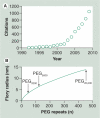Nanoparticle PEGylation for imaging and therapy
- PMID: 21718180
- PMCID: PMC3217316
- DOI: 10.2217/nnm.11.19
Nanoparticle PEGylation for imaging and therapy
Abstract
Nanoparticles are an essential component in the emerging field of nanomedical imaging and therapy. When deployed in vivo, these materials are typically protected from the immune system by polyethylene glycol (PEG). A wide variety of strategies to coat and characterize nanoparticles with PEG has established important trends on PEG size, shape, density, loading level, molecular weight, charge and purification. Strategies to incorporate targeting ligands are also prevalent. This article presents a background to investigators new to stealth nanoparticles, and suggests some key considerations needed prior to designing a nanoparticle PEGylation protocol and characterizing the performance features of the product.
Figures





References
-
- Wagner V, Dullaart A, Bock A, Zweck A. The emerging nanomedicine landscape. Nat. Biotechnol. 2006;24(10):1211–1218. - PubMed
-
- Kim BY, Rutka JT, Chan WC. Nanomedicine. N. Eng. J. Med. 2010;363(25):2434–2443. - PubMed
-
- Jacobson GB, Gonzalez-Gonzalez E, Spitler R, et al. Biodegradable nanoparticles with sustained release of functional siRNA in skin. J. Pharm. Sci. 2010;99(10):4261–4266. - PubMed
-
- O'Brien ME, Wigler N, Inbar M, et al. Reduced cardiotoxicity and comparable efficacy in a Phase III trial of pegylated liposomal doxorubicin HCl (CAELYX/doxil) versus conventional doxorubicin for first-line treatment of metastatic breast cancer. Ann. Oncol. 2004;15(3):440–449. - PubMed
Publication types
MeSH terms
Substances
Grants and funding
LinkOut - more resources
Full Text Sources
Other Literature Sources
